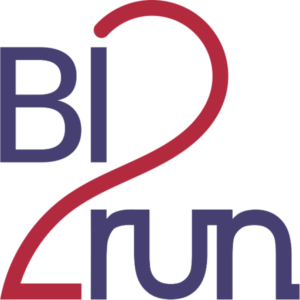Using KPIs correctly in reporting: Learn which key figures really have an impact and how BI2run helps you to set up focused, targeted reporting with IBM Planning Analytics.
From a sea of data to a compass for decision-making
There are many key figures. But very few of them actually lead to clear decisions. Often, long Excel tables dominate, in which relevant information is hidden behind metrics and colors. What is missing is clarity. Orientation. Impact.
KPIs – key performance indicators – are designed to deliver precisely that. But only if they are carefully selected, presented in a comprehensible manner, and linked to a genuine goal.
In this article, we show you how to select, structure, and communicate KPIs in reporting in a meaningful way and how to use IBM Planning Analytics and BI2run to develop a real control compass for your company.
What are KPIs and why are they so important in reporting?
KPI vs. metric: a subtle but crucial difference
Every number in the system is a metric. But only a few of them are truly relevant to decision-making. KPIs are metrics that are closely linked to strategic goals. They show how well (or poorly) a company is performing.
Revenue is a metric. Revenue per product group compared to the quarterly target? That’s a KPI.
Think KPIs operationally, tactically, strategically
- Operational: Daily KPIs for production, sales, logistics
- Tactical: Monthly key figures for budget control, personnel development
- Strategic: Quarterly or annual figures for strategy review
It is important to note that every KPI needs a target, a benchmark, and a rationale for action. Otherwise, it remains nothing more than a pretty number on the dashboard.
Why many reports say little
The paradox: the more KPIs there are in the report, the less clarity there is. Many companies struggle with:
KPI overload
If a report contains 48 key figures, each individual figure loses its significance. Decision-makers cannot see the forest for the trees and fail to react at all.
Lack of target references
A KPI without a target value is like a compass without north. You know where you are, but you don’t know if you should be there.
Separation of action and information
Reports that “only show” but do not provide any impetus for action generate little added value. Good KPIs combine analysis with control.

The most important KPI categories in reporting
Financial KPIs
- Revenue
- EBIT / EBITDA
- Cash flow
- Working capital ratio
Sales KPIs
- Lead-to-deal conversion rate
- Opportunity pipeline coverage
- Customer churn rate
Controlling KPIs
- Forecast Accuracy
- Budget deviation
- Cost per FTE
HR, IT, and ESG KPIs
- Staff turnover rate
- CO₂ emissions per product
Not every area needs everything. The decisive factor is relevance to corporate management.
KPI selection: Less is more
Good reporting is like a good dashboard in a cockpit: only the truly relevant displays are visible. The following applies to a meaningful selection of KPIs:
Target group focus
What interests a CFO – and what interests HR management? Reports must be tailored to the audience, otherwise their impact will be lost.
KPI design according to the SMART principle
- Specific
- Measurable
- Accepted
- Realistic
- Time-bound
Reduction as the key
One CIO put it aptly: “Five well-chosen KPIs say more than 50 irrelevant figures.”
IBM Planning Analysis and KPI Reporting
With IBM Planning Analytics, KPI reporting becomes not only flexible, but also real-time and effective for management purposes.
- Data centralization All KPIs access the same database – no discrepancies, no Excel chaos.
- Flexible dashboards Reports can be accessed according to target group, time period, or scenario – directly on the web, on mobile devices, or in Excel.
- Forecasting & scenarios What happens to the EBIT margin when raw material prices rise? With Planning Analytics, you can simulate and evaluate KPIs directly.
BI2run: Your partner for razor-sharp KPI reporting
Methodology meets technology
BI2run combines business management KPI expertise with technical excellence – gained from numerous projects.
- KPI workshops with stakeholders
- Reduction logic & governance concepts
- Implementation in IBM Planning Analytics
Enablement & Rollout
We ensure that not only does the system run smoothly, but that people also understand and use it.

Mini case study: How a medium-sized company achieved greater impact with 5 KPIs
A medium-sized industrial company had over 70 KPIs in use. But none of them were used regularly. Why? Too much information, too little structure.
BI2run conducted a structured KPI workshop, developed a new KPI set with only 5 key performance indicators – and implemented it in IBM Planning Analytics.
The result:
- Clarity in reporting
- Shorter meetings, better decisions
- KPIs were finally taken seriously—because they were relevant
FAQ – Frequently asked questions about KPI reporting
How many KPIs should a good report contain?
Depending on the target group, 3–7 per dashboard. Anything more than that becomes confusing.
What is the difference between KPIs and OKRs?
KPIs measure performance, OKRs formulate goals. They complement each other – but are not in competition with each other.
Can IBM Planning Analytics calculate KPIs automatically?
Yes – including trend analyses, scenarios, and forecasts.
How does BI2run ensure that the KPIs are meaningful?
Through methodical workshops, stakeholder participation, and a proven review framework.
Fewer KPIs, greater impact with BI2run as your reporting compass
KPI reporting is not an Excel export with a bar chart. It is a control tool—and deserves attention accordingly.
With a clear set of KPIs, sophisticated visualization, and a robust platform such as IBM Planning Analytics, you get exactly that: reporting that guides decisions.
BI2run accompanies you on this journey – with methodology, technology, and practical expertise.
Rethinking reporting with BI2run
Want clarity instead of rampant KPIs? Start your new reporting now – with BI2run as your partner.







